#ce: 19th century
Text
Fastest Growing Fandoms on AO3 This Week (03/27/2024)
Every week I pull data on how many fics are in each fandom and compare to the previous week, then calculate the percentage increase to determine fastest growing fandoms. Since this naturally skews towards smaller fandoms, I have included the same data filtered to Over 1k, 5k, & 10k fics.
Overall:
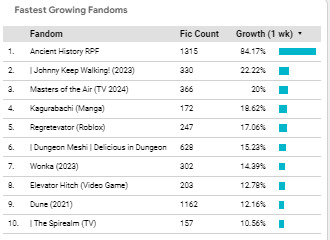
Over 1,000 Fics:

Over 5,000 Fics:

Over 10,000 Fics:
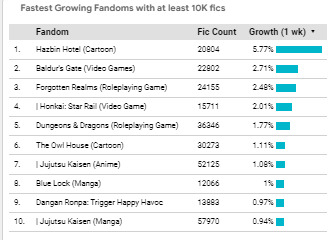
Source: AO3 Fandom Dashboard
#ao3#ao3 stats#Ancient History RPF#Johnny Keep Walking!#Masters of the Air#Kagurabachi#Regretevator#Dungeon Meshi Delicious in Dungeon#Wonka#Elevator Hitch#Dune#The Spirealm#19th Century CE RPF#Love and Deepspace#20th Century CE RPF#Hazbin Hotel#Doctor Who#Sally Face#PHIGHTING!#Young Royals
43 notes
·
View notes
Photo

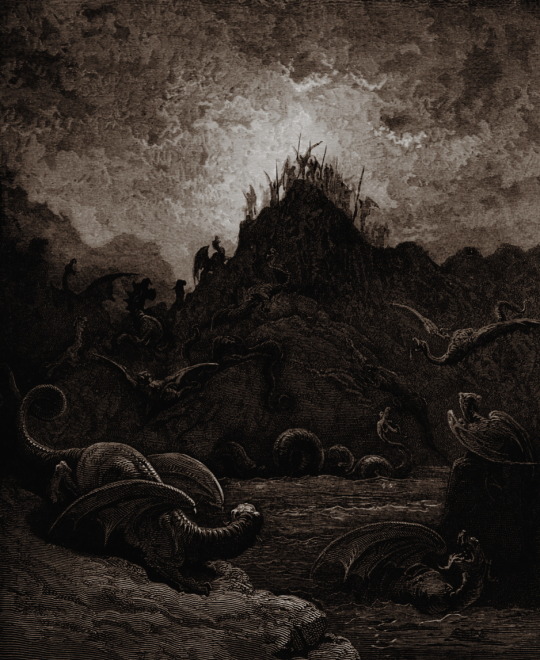
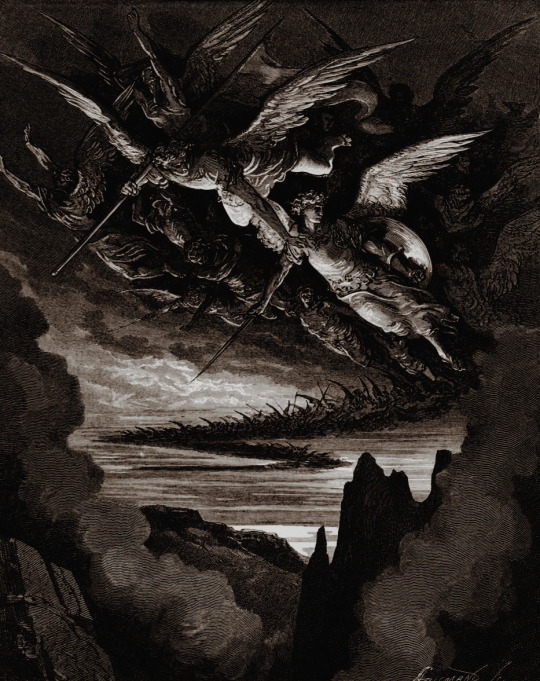
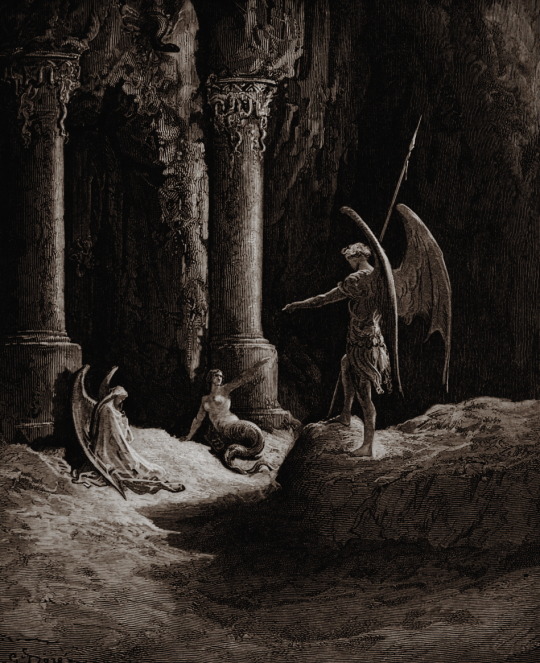
𝔊𝔲𝔰𝔱𝔞𝔳𝔢 𝔇𝔬𝔯é
#Gustave Doré#Satan's fall#Paradise Lost#Satan’s Fall#artwork#art#Illustration#painting#1866#19th Century Art#19th ce#XIX century#illustrations
738 notes
·
View notes
Text
not to be about opera again but to be about opera again. as an art form it has the reputation of being super stuffy and something for snobs who don't know how to have fun only but honestly this was one of, perhaps even THE main theatrical entertainment for centuries. i wish people knew how hard these things can go and how engaging they can be. like characters kill and die and fight wars and (almost) commit human sacrifice left and right. characters fall in love they mourn they're ecstatic they cry they're furious it's an extremely dramatic and emotional art form! and i understand that opera does not appear approachable bc of the general conventions of the art form but i promise old works can be fun and engaging if you go watch them with some preparation beforehand (reading the libretto helps) - not to mention not all operas are old bc there are so many modern operas which engage with topical events! also the music slaps.
#le triomphe de trajan (1807) out here calling for a man's execution with this banger:#point de grace pour ce perfide; que tout sons sang coule sur un autel#(no grace for this treacherous man; let all his blood flow on an altar)#this is also annoying to me when people write historical fic and the characters treat the opera as this elitist thing#that they don't know anything about.#you know when they go to the opera reluctantly and then they have no idea what's going on on stage or who the composer is.#which is. very unlikely for anyone with the money to attend an opera in certain opera houses in the 19th c. tbqh#like im more of an expert on paris and vienna idk what it was like in london#but if you were decently (upper) middle class or nobility (esp in paris) you went regularly. this was like a whole social space too#i recently read a fanfic and one of the characters was like 'oh it's in italian. i don't know that' and the other character went like#'it's by a man called donizetti what did you expect'#(this was situated in 19th century london)#like first of all. donizetti was NOT a librettist he was a composer he did not write the text#and second of all. he worked on french operas ?? so did rossini. and spontini.#opera was an incredibly international art form. also bc productions would be performed in different countries all the time#(sometimes changed and/or translated but not necessarily)#and again like i said. this was one of THE main forms of entertainment. people were familiar with its conventions! it was well-liked!#ofc bc of the seating prices it was not very accessible to lower classes most of the time#but lbr most characters that get written into an opera scene in fiction are at the very least decently bourgeois lol#i wish people knew how to properly historicise forms of entertainment whose reputation has changed in the modern era#from what it was a century or more ago#very adjacent to people 'cancelling' old lit bc of 'bad takes' like idk how to tell you this but people thought different back then#completely different world view from what we have today. that does not make lit from that era irredeemable it is just from a diff. time#acknowledging that and reading the text critically but also still enjoying it are things that go tgt here#ok rant over (it is never over)#curry rambles
10 notes
·
View notes
Text
CE 1897: Footage of Jerusalem
youtube
View On WordPress
0 notes
Photo

Historical Fiction of Mesopotamia
Historical fiction is frequently dated to works including the Iliad of Homer (8th century BCE) or The Tale of Genji (11th century CE) or, in English, to the 19th century, usually to the works of Sir Walter Scott, but the genre has more ancient origins dating back to the 2nd millennium BCE through Mesopotamian naru literature.
Continue reading...
143 notes
·
View notes
Text

Horse Handle Lapis Lazuli Dagger khanjar, Persian, 19th Century CE.
The Al-Sabah Collection, Kuwait
#ancienthistory#archeology#archaeology#arkeoloji#antiktarih#archaeologist#archaeologylife#architecture
4K notes
·
View notes
Text

Bada Bagh, Jaisalmer, Rajasthan, India: Bada Bagh, also called Barabagh is a garden complex located about six kilometers north of Jaisalmer in the Indian state of Rajasthan. Overlooking a mango grove sits a set of royal chhatri cenotaphs constructed by the Maharajas of the Jaisalmer State in the 18th, 19th, and early 20th centuries CE. Wikipedia
56 notes
·
View notes
Note
"oh barbie was the first woman dol, it was only babies before her"
crepereia tryphaena didn't die for this kind of slander
you are so right
crepereia tryphaena (2nd or 3rd century CE) did not die at the age of 20 and get buried with her clearly beloved ivory lady doll for this
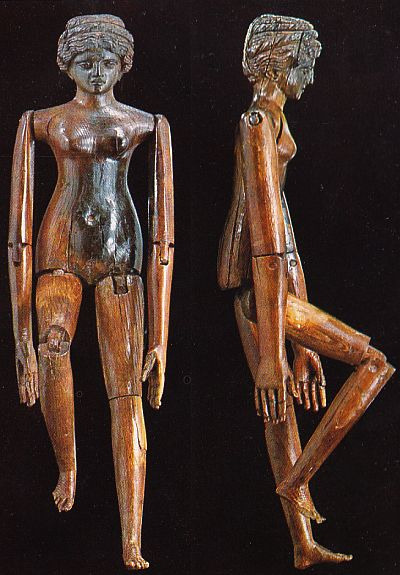
(this doll had fucking JEWELRY. and G*rwig says Barbie was the first fashion doll? give me a break)
honestly, most of the Firsts or Onlys people want to attribute to Barbie aren't real.
"but she was the first fashion doll meant for play, not just showing off clothing!"
there's actually less evidence of dolls meant only for displaying new fashions in history than dolls intended for children to play with AND to incidentally show their mothers and older sisters the latest styles. even so-called "milliners' models" of the late 18th-early 19th century are now believed to have been primarily toys
"but she was the first one with a [cis] woman's body!"
see above. the ancient Roman doll has breasts. she was not the last doll with breasts before Barbie- and lots of the intervening lady dolls weren't flat due to prudishness as many suppose, but because the same bodies were often used for male dolls. saves money, work, and time to just bang out a bunch of gender-neutral stuffed or carved bodies and let the clothes and hair determine the gender. Creatable World isn't new, either
the reson for Barbie's massive success wasn't that she was the First Fashion Doll in a sea of baby dolls. it's that she filled a very specific niche that was empty when she came along: a small, relatively affordable fashion doll that gave a 3-D paper doll experience. (Everyone likes to talk about Barbie's roots with the Bild Lilli doll; nobody brings up that Ruth Handler was equally inspired by her daughter's movie star paper dolls.)
lady dolls WERE scarce when Barbie came out, and she DID face pushback for her adult, somewhat sexy look. That's true. But she was not unique in history- she was just the right idea, in the right place, at the right time
#ask#anon#dolls#doll history#ancient history#ancient rome#barbie#I don't hate barbie or anything! I have two vintage Barbies who are married and changing their clothes seasonally delights me#I just hate Mattel stealing earlier fashion dolls' thunder
370 notes
·
View notes
Text

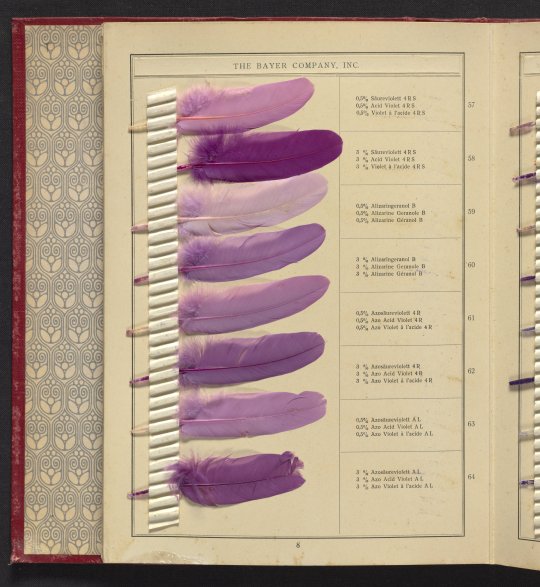
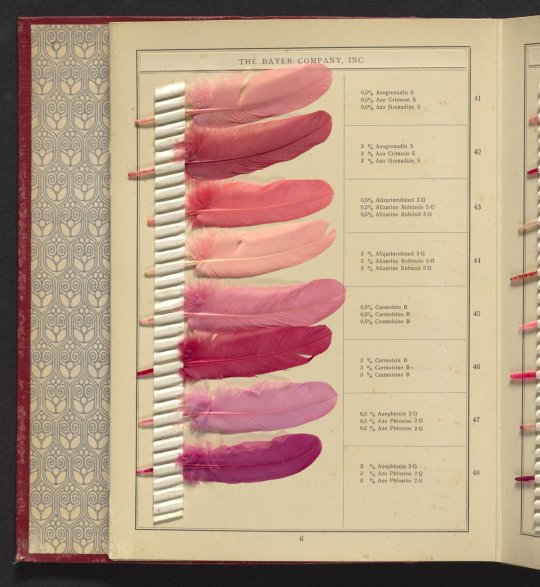
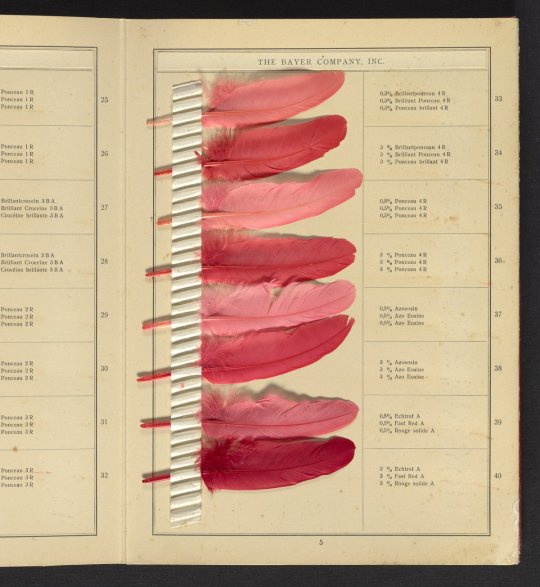

Ausfärbungen auf Federn / Teintures sur Plumes or Shades on Feathers is a sample book from 1915 with dyeing instructions and an 18-section foldout containing 143 dyed feathers. Published by the Bayer Company of New York City in English, French
and German, the book begins with instructions for dying feathers (clean them in soap and ammonia, then boil in salts and sulphuric acid).
Humanity has been colouring things for millennia. Scientists have found evidence of the first natural reds and oranges in tombs back to 2600BC.
Written in Greek, the Papyrus Graecus Holmiensis (also known as the Stockholm papyrus) is a 4th century CE codex of craft recipes compiled in Egypt. The work’s 15 leaves contain 154 recipes for the manufacture of dyes and colours used in fashioning artificial stones.
Recipe 101 is as follows:
“Cold Dyeing for Purple which is Done in the True Way”
“Keep this as a secret matter because the purple has an extremely luster. Take scrum of woad from the dyer, and a sufficient portion of foreign askant of about the same weight as the scum – the scum is very light – and triturate it in the mortar. Thus dissolve the alkanet by grinding in the scum and it will give off its essence. Then take the brilliant color prepared by the dyer – if from kermis it is better, or else from kirmnos – heat, and put this liquor into half of the scum in the mortar. Then put the wool in and color it unmordanted and you will find it beyond all description.”
Back then, purple was the marker of rank and class.
The most well-known shellfish dye was the Tyrian purple, royal purple or imperial purple as it was called, which came from sea snails in the Eastern Mediterranean in the ancient city of Tyre. This dye was very special for all the civilisations around the Mediterranean and its use spanned whole centuries. It was the most expensive dye in the whole of ancient world, as the colour it produced was very bright and colourfast. Because of its properties, its use was restricted for royals, members of the royal family, and senior public officers and priests.
Archaeological evidence points out that the ancient Phoenicians first discovered and used it (Tyre was an important Phoenician city). From them, it became known to ancient Greeks, Romans and through them in Byzantium and Medieval Europe. It was so sought after that the Byzantine emperor Theodosius I prohibited its use from the lower classes or the penalty was death. The privilege of using this purple dye is so profound that the phrase “born in purple” was born in that period. In Western Europe, it was replaced in prominence around the 12th century, and finally went out of fashion around the 19th century, when a synthetic purple was invented and thus it became more accessible to the wider masses.
https://flashbak.com/shades-of-feathers-a-beautiful.../
101 notes
·
View notes
Text
Free!
"Leave our country alone!"
they say
"This isn't your land -
go back to where you came from!"
And as my brother's being shoot,
And my sister's being paraded naked -
For their great sin of: living
[Re'im, Israel, 2023]
As my great-grandfather was pushed down in the streets
And his beard was brutally shaved
As they raped and enslaved and murdered-
[Birkenau, Poland, 1943]
[just like in 1941 Farhud, Iraq ; Jedwabne pogrom; 1945 Tripoli pogrom, the 1946 Kielce pogrom, and the 1947 Aleppo pogrom]
In 1934 there were pogroms against Jews in Turkey and Algeria.
Other parts of my family were lucky enough to survive the 1929 Hebron massacre during the 1929 Palestine riots.
[Mandatory Palestine under British administration]
In 1919, soldiers marched into the center of town accompanied by a military band and engaged in atrocities under the slogan: "Kill the Jews, and save the Ukraine." They were ordered to save the ammunition in the process and use only lances and bayonets during the Proskurov pogrom.
[Proskurov, Ukraine, 1919]
[100 years, and nothing changed, huh?]
You know, my grandma's arab. I still remember sitting in class in high school, hearing about the 1840 Damascus affair, and thinking:
hu.
I'll skip several years and countries, but:
Their grandparents were there to witness as the outbreak of violence against Jews (Hep-Hep riots) occurred at the beginning of the 19th century.
The 1821 Odessa pogroms marked the beginning of the 19th century pogroms in Tsarist Russia
That's Khmelnytsky Uprising of 1648–1657 in present-day Ukraine.
So they said, during the attacks against Jews also took place in Barcelona and other Catalan cities during the massacre of 1391.
Their ancestors were cast away and murdered in Spain, 1492.
The same way we were banished and cast away from Bern (1427) and Zürich (1436) for almost 400 years?
Let us not speak of the alaughter on Holy Saturday of 1389, a pogrom began in Prague that led to the burning of the Jewish quarter, the killing of many Jews, and the suicide of many Jews trapped in the main synagogue; the number of dead was estimated at 400–500 men, women, and children.
Brussels massacre of 1370.
Or - do you want to hear about the 510 jewish communities that were destroyed? (1348-1350)
including in Toulon, Erfurt, Basel, Aragon, Flanders[16][17] and Strasbourg.[18]
Just like Rhineland massacres in 1096
Some of them made it to England, around 1060.
It took less than 30 years for the first Podrom in 1189-90 in England,
Oh, and let us not forget 1066 Granada massacre [again, in Spain].
Or the Alexandria in the year 38 CE, followed by the more known riot of 66 CE.
The Jewish population of the land on the eve of the first major Jewish rebellion [66 CE] may have been as high as 2.2 million. The monumental architecture of this period indicates a high level of prosperity.
In 66 CE, the Jews of Judea rose in revolt against Rome, sparking the First Jewish–Roman War. The reverse seized control of Judea and named their new kingdom "Israel"
The revolt was crushed by the Roman emperors Vespasian and Titus. The Romans destroyed much of the Temple in Jerusalem and took as punitive tribute the Menorah and other Temple artifacts back to Rome. Josephus writes that 1,100,000 Jews perished during the revolt, while a further 97,000 were taken captive. The Fiscus Judaicus was instituted by the Empire as part of reparations.
[And here we come to a full cycle of blood, land, and pain].
And those are only those I found out about. Only those we have a record of. Only those we know to this day. They were so massive, or left enough impact so we still remember.
[I could go on, this is just a short list.]
It seems like no matter what we do, we'll always be accused for
Let me know, please - where can I be a jew, and just
Live?
#israel#jews#jewish history#history#palestine#Juda kingdom#pogrom#pogroms#terror#manslaughter#massacre
135 notes
·
View notes
Text
Sometimes I think about material archaeology and our modern conveniences and I think about just how hard it would be to rebuild all this. How many billions of hours and billions of people it took over the existence Homo Sapiens to take us from the most basic tools like fire and bone tools to the present. This isn’t a moralizing statement. This is simply a fact.
It is so hard to build anything from scratch. Truly from scratch, out by yourself in the middle of the woods. Sometimes I’ll just pick an object and think of all the materials in it and how long it took humankind to discover how to build it the way we do today. To transport it. Little things like floor tiles, or a pair of scissors, and more complex things like plumbing systems and communication lines and roads that can handle the weight of a vehicle.
Do you know it’s possible to tell when a building was made by the quality and size and color of the bricks where I live? Some are 300 years old which is old for the US. Some are a different color than the other bricks so you know the building was made after railroads, so the bricks come from a different part of the country. The bricks we make today are mass produced and the lines much more perfect than the bricks of the 19th century. You can see where modern bricks were used to restore old buildings by the change in color and where old windows were closed up.
Did you know you can tell the age of Roman statues and portraits from the hair and the eyes because luxurious curly hair could not be done until the 2nd c CE because certain drill tips that allowed it had not been invented yet, so curled hair was suggested by lines on the scalp? Many forms of art can be identified by when the technology that allowed them came into being.
Our ancestors weren’t genetically dumber than us. They just had fewer tools. Tools develop over time and starting from zero was excruciatingly difficult it took millions of years to reach a point where writing could be conceived of and invented in a way that allowed the spreading of this knowledge from one place and generation to the next. Then, people could start to build one discovery on top of another and not lose it in a few generations.
Anyway, I think about this sometimes. The invisible complexity of the material world and the rules it sets by the availability of the tools needed for certain items that we simply use and accept as part of our lives. And how hard it would be to do it all over again.
279 notes
·
View notes
Text
Fastest Growing Fandoms on AO3 This Week (03/25/2024)
Every week I pull data on how many fics are in each fandom and compare to the previous week, then calculate the percentage increase to determine fastest growing fandoms. Since this naturally skews towards smaller fandoms, I have included the same data filtered to Over 1k, 5k, & 10k fics.
Overall:
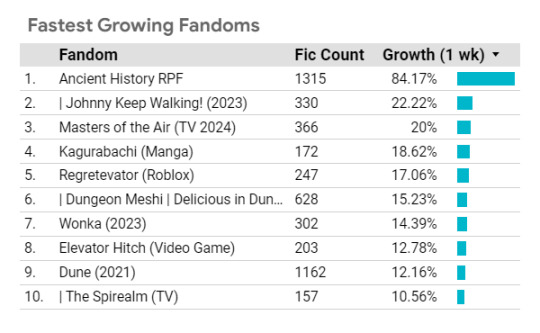
Over 1,000 Fics:

Over 5,000 Fics:
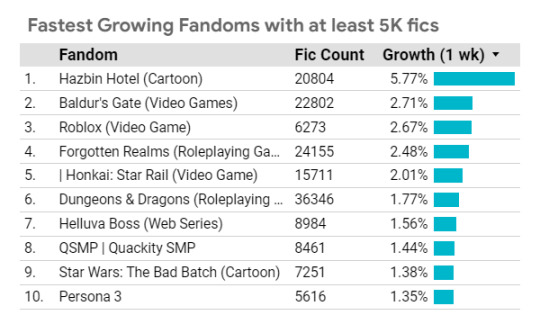
Over 10,000 Fics:

Source: AO3 Fandom Dashboard
#ao3#ao3 stats#Ancient History RPF#Johnny Keep Walking!#Masters of the Air#Kagurabachi#Regretevator#Dungeon Meshi Delicious in Dungeon#Wonka#Elevator Hitch#Dune#The Spirealm#19th Century CE RPF#Love and Deepspace#20th Century CE RPF#Hazbin Hotel#Doctor Who#Sally Face#PHIGHTING!#Young Royals
30 notes
·
View notes
Photo

Horse Handle Lapis Lazuli Dagger khanjar, Persian, 19th Century CE. The Al-Sabah Collection, Kuwait. [640 x 809]
#Horse Handle#Lazuli#Dagger khanjar#Persian#dagger#19th Century#xix century#Sabah#Al-Sabah#Collection#Kuwait
893 notes
·
View notes
Note
You are my hero for using the phrase 'perfidious Albion' in your tags. What is the French obsession with Alexandrine meter?
:) Well it's just that for a very long time France considered the 12-syllable verse known as the alexandrine to be the pinnacle of versification. For your poetry or play to be considered high literature it had to be in alexandrines (I was recently reading an English jstor article about translations of Shakespeare in the early 19th century and it went “[French translator] prefers to translate in verse, which means, of course, in alexandrines.” Of course!) We've moved on now and they’re out of style, but we’re still secretly fond of them I think. We were held hostage by alexandrines for so long a lot of French people still have a Stockholm-syndrome preference for their specific flow over other kinds of poetic metre.
They left a strong legacy in our language too—a lot of French sayings / proverbs are alexandrine verses because they’re excerpts from classical theatre and poetry (e.g. “A vaincre sans péril on triomphe sans gloire” from Corneille; “La raison du plus fort est toujours la meilleure” from La Fontaine; “Qui veut voyager loin ménage sa monture” from Racine; “Chassez le naturel, il revient au galop” from Destouches, “Vingt fois sur le métier remettez votre ouvrage” from Boileau...)
The alexandrine had a long golden age, from the Classicists to the Parnassians (mid-17th to late 19th century)—the Romantics in between were advocating for a kind of “free verse” but it still meant alexandrines and pretty rigid ones at that! (Victor Hugo’s “J’ai disloqué ce grand niais d’alexandrin” was subversive—but it’s still an alexandrine.) Their verse was only considered rebellious because it ignored some of the many rules that went into a perfect classical alexandrine (e.g. no overflow, 4 rests per line, rhyme purity must be respected when it comes to mute consonants, no liaison between the last word of an alexandrine and the first word of the next, the hemistiches of two successive alexandrines mustn’t rhyme, no prepositions or other tool words at the end of a hemistich, etc. etc.)
Then in the 19th century we liberated ourselves from the tyranny of the alexandrine after Verlaine shot them dead (insert Rimbaud joke) by doing things like placing the caesura on the 3rd syllable of a 5-syllable word (“WTF”—Racine) or ending an alexandrine in the middle of a word and treating the first half of the truncated word like a legit rhyme, which made all the Classicists roll over in their grave.
I really like alexandrines personally! I admit they can sound plodding after a while especially with classical rhymes, but they have such a soothing flow. I also love that they are often French at its Frenchest. By which I mean, there are some gorgeous alexandrines that are genuinely the French language at its best and most graceful, and then you have those that can’t help but highlight how absurd our syntax can get.
My favourite types of alexandrines are the ones with a diaeresis in each hemistich because saying them normally feels like walking down the street, while saying them as an alexandrine feels like doing a figure skating routine (e.g. in Racine, “La nation chérie a violé sa foi”); the ones with an AB-BA structure (“Et le fuyant sans cesse incessamment le suit”), the ones with a ternary structure (“Je suis le ténébreux, le veuf, l’inconsolé”, “Je renonce à la Grèce, à Sparte, à ton empire”) and the ones where 1 word sprawls over an entire hemistich (“Voluptueusement dans cette paix profonde...”).
The worst alexandrines imo are the ones that force you to acknowledge how many tiny grammatical bricks are involved in the building of a French sentence. Orally we tend to squish them together so we can forget about them but the merciless alexandrine will demand that you mortify yourself pronouncing all of them, e.g. “O nuit, qu’est-ce que c’est que ces guerriers livides ?” (thank you Victor Hugo for this ignominy) (<- here’s an alexandrine), or “Si ce que je te dis ne se dit pas ainsi”... “Ce que je te (...) ne se” is a horrible succession of words by poetical standards but wait I’ve got worse!
Tu m’as pris mon trésor et t’étonnes tout bas
De ce que je ne te le redemande pas
“De ce que je ne te le”—see? French at its Frenchest.
#ask#language tag#(french speakers tell me your favourite alexandrine if you have one!)#ce dernier couplet provient d'un livre sur la poésie de hugo qui m'a surtout marquée parce qu'à un moment#l'auteur consacre plusieurs pages à citer des vers dont le contenu terre à terre contraste ridiculement avec#la grandiloquence inévitable de l'alexandrin#et c'est vrai que certains sonnaient plus comme une réplique de trissotin qu'un vers de la légende des siècles#mais quand même t'écris un bouquin sur victor hugo et tu décides de passer 20 pages à lui mettre la honte
484 notes
·
View notes
Text
CE 1945: Footage of Palestine
March of Time — outtakes — Mosque; Arabs in Palestine, accessed at United States Holocaust Memorial Museum, courtesy of National Archives & Records Administration (https://collections.ushmm.org/search/catalog/irn1001122)
Events shown
Road junction with Syrian and Transjordanian borders. Buses, signpost “Jerusalem Trans Jordan South” and “Frontier Syria”. 06:32:45 Desert, cows, sea. People on…

View On WordPress
0 notes
Photo

Cahokia
Cahokia is a modern-day historical park in Collinsville, Illinois, enclosing the site of the largest pre-Columbian city on the continent of North America. The original name of this city has been lost – Cahokia is a modern-day designation from the tribe that lived nearby in the 19th century – but it flourished between c. 600-c. 1350 CE.
Continue reading...
107 notes
·
View notes